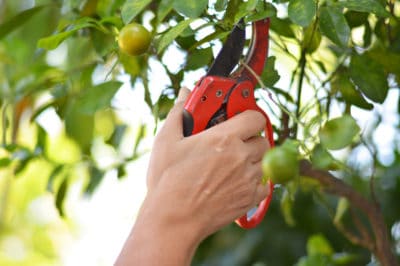When to Prune
Prune orange trees between February and April. The only exceptions to this rule are sprouts and suckers growing below the trees’ main branches. Prune them from February to October. If removed in winter, they may grow back, suffer frost damage and injure the entire tree.
Things You’ll Need
- Bypass pruners
- Curved saw
- Branch loppers
- Pole pruner (for larger trees)
Always use sharp, sterile tools to prune your trees. Rinse them periodically in rubbing alcohol while you work and again before putting them away.
How to Prune Orange Tree Sprouts and Suckers
Snap small sprouts off the trees or snip them with bypass pruners. If they’re too large for that, saw them off at base but leave the branch collars intact. Those are the swollen trunk areas at the bases of every branch.
Expert gardener’s tip: Intact branch collars help the trees heal quickly and discourage new sprouting.
Pruning Suckers
Orange trees grafted onto rootstock from another variety frequently send out vertical shoots called suckers. Unless removed, they’ll steal water and nutrients from the fruit-producing branches above.
As soon as a sucker appears, remove it with bypass pruners just above a branch collar. If it’s sprouting directly from the root, cut it off as close to the soil as possible.
Pruning Orange Trees’ Branches
Prune branches if they’re:
- Dead, damaged or diseased
- Crossing
- Rubbing each other or the fruit
- So dense that no sunlight is penetrating the canopy
Prune branches up to 1 ½ inches in diameter with a bypass pruner or lopper. Larger ones need a fine-or coarse-toothed circular saw and a three-way cut.
To make the three-way cut:
- Saw one-third of the way through the branch at a spot 6 inches to 1 foot above the collar. Make this cut on the underside.
- Move three inches further from the collar and cut all the way through the branch. Let its end section drop off.
- Cut the branch stub back to the collar.
Expert gardener’s tip: Don’t worry about leaving the cut area exposed. To protect itself from infection, your tree will form a callus over the wound, starting at the edges and moving inward.
